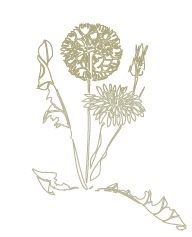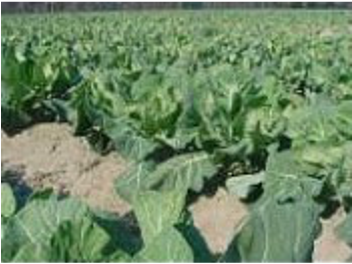Effective weed control throughout the entire growing season is especially important for leafy greens. As with any crop, controlling weeds in greens is important to avoid reduced yield and quality from competition for nutrients, water, and light.
Growers of leafy greens, however, have another threat to consider: direct contamination. The presence of weeds in greens can result in lower prices or rejection at market.
The marketable portion of collards, kale, mustard, and turnips (grown for greens) is the above-ground leaf. Weeds that remain in the field at harvest can reduce efficiency by forcing field personnel to slow down to avoid harvesting weeds. The potential for contamination is greatest in machine-harvested greens. Machine harvesters cannot discriminate between weed and crop as hand laborers can.
Greens are cool-season crops, and the weed spectrum that confronts them is different from the weed spectrum faced by warm-season crops. Of particular concern are weeds that could contaminate the crop, such as winter annual broadleaf weeds and common lambsquarters. Many grass species can also germinate late in a spring crop and cause contamination issues.
Cultivation Options in Greens
If possible, use cultivation to help control weeds in greens. Cultivate to a shallow depth to avoid injuring crop roots (Sanders, 2001). Cultivation capability will depend on row spacing. Greens are typically grown in rows spaced from 12 to 30 inches apart. Cultivation of narrower rows can be time-consuming and costly, whereas wider row spacing can accommodate cultivation activities as in field crops.
Herbicide Options in Greens
Preplant and Preemergence
Glyphosate (Roundup and other trade names) may be applied prior to crop transplanting or emergence for control of emerged weeds. It will control susceptible weeds. Apply 0.5 to 1.5 pounds of active ingredient per acre. The rate of product per acre will change based on the particular formulation used. Perennial weeds may require higher rates of glyphosate. Be aware that some formulations of glyphosate have been manufactured with surfactants included and need no further adjuvants. Do not feed crop residue to livestock within eight weeks of application. See the product label for further details.
Paraquat (Gramoxone Inteon 2 SL, Gramoxone Max 3 SL, Firestorm 3 SL) may also be used to control emerged weeds prior to crop emergence. Paraquat will not translocate in plants as well as glyphosate. Therefore, application should be made to small weeds. Preform beds several days before application to encourage maximum weed germination and emergence prior to treatment. Apply Gramoxone Inteon at 2.6 to 4 pints per acre and Gramoxone Max or Firestorm at 1.5 to 2.7 pints per acre (0.65 to 1 pound active ingredient per acre). These products may be applied with either a nonionic surfactant (16 to 32 ounces per 100 gallons of water) or a crop oil concentrate (1 gallon per 100 gallons of water). Paraquat used for preplant weed control over plastic mulch may injure transplanted crops that contact the plastic. Sufficient rainfall or irrigation is required to remove residual paraquat prior to transplanting. Since paraquat does not translocate within the plant, it has limited effectiveness on perennial weeds.
Trifluralin (Treflan 4 EC and others) may be applied at 1 to 1.5 pints of product per acre (in specific situations, the label allows 2 pints per acre) prior to planting and incorporated into the soil to a depth of 2 to 3 inches. Incorporation should occur within 24 hours of application. Trifluralin will control annual grasses and small-seeded broadleaf weeds. If direct seeding the crop and trifluralin is incorporated into cool, wet soil, reduced stand and stunting may occur. On coarse and medium soils (sand, loamy sand, sandy loam), use the rate of 1 pint per acre. On heavier soils, higher rates may be necessary. See the label for specific instructions on soil considerations as well as instructions related to different incorporation devices. Do not use this product if turnip roots will be consumed.
Bensulide (Prefar 4 EC) is registered for use only on mineral soils as a preplant-incorporated or preemergence treatment in many greens. It cannot be used in turnips. See the label for complete information. The Prefar label claims control of only grass species when used in states other than Arizona, New Mexico, Texas, and California. The use rate is 5 to 6 quarts per acre, with a maximum of 6 quarts per acre in one season. Incorporation to 1 inch is recommended if applying prior to planting. Research experience has shown that when using Prefar preemergence, irrigating immediately after application is required for best activity.
DCPA(Dacthal W-75) may be preplant-incorporated or broadcast to the soil when greens are seeded or immediately after transplanting. The labeled use rate is 6 to 14 pounds of product per acre, depending on soil type. At lower labeled rates, Dacthal will control carpetweed, common chickweed, common lambsquarters, and several common annual grasses. As rates are increased, more weeds are susceptible (see label). The Dacthal label states that incorporation to depths greater than 2 inches may result in reduced herbicidal activity. It will not control nutsedge species.
Postemergence
Glyphosate (Roundup WeatherMax 5.5 L) may be applied as a hooded or shielded spray or wiper application to row middles between crop rows. Glyphosate must not contact the crop. Apply at 0.5 to 0.94 pounds active ingredient per acre or 11 to 22 ounces of product per acre. Be aware that some formulations of glyphosate have been manufactured with surfactants included and need no further adjuvants. Glyphosate may not be applied within 14 days of harvest.
Clopyralid (Stinger 3 EC, Clopyr AG 3 EC) will control most legume weeds, such as vetch and clover. Vetch can be a problem in spring greens because their growing seasons coincide. Clopyralid is an excellent choice for controlling vetch postemergence. It is labeled for use on kale, collards, mustard, turnips, mustard spinach, and rape. Clopyr AG is also registered for use in turnips. See the label for a complete crop list. Do not apply within 30 days of harvesting kale, collards, mustard, and turnips grown for roots. In turnips grown for greens, do not apply within 15 days of harvest. The Stinger label specifically states that it does not control mustards, henbit, chickweed, kochia, lambsquarters, pigweed, Russian thistle, and bindweed.
Clethodim (Select 2 EC and other trade names, Select Max 1 EC) and sethoxydim (Poast 1.53 EC) may be used postemergence for control of emerged grass species. Neither of these products will have activity on broadleaf weeds or nutsedge species. Differences in grass control from the two products, applied at labeled rates, are small. However, Select is more efficacious on annual bluegrass than Poast. Select is also considered slightly better at controlling perennial grasses, such as bermudagrass.
Poast can be applied at 1 to 1.5 pints per acre. It is recommended that you include a crop oil concentrate at 1 quart per acre with Poast. Rates of Select range from 6 to 8 ounces per acre. Again a crop oil concentrate is recommended. When using Select, the crop oil concentrate should be added at a rate of 1 quart per 100 gallons of water. Adding a crop oil concentrate to either of these products may increase the chances of crop injury. Apply these products on days that are not unusually hot or humid.
Select Max (1EC) may be applied at 9 to 16 ounces per acre for emerged grass control. The label for Select Max allows the use of a nonionic surfactant at 2 pints per 100 gallons of water to reduce the risk of crop damage that may occur by using a crop oil concentrate.
Do not apply Poast within 30 days of greens harvest. Do not apply Select or Select Max within 30 days of turnip root harvest or within 14 days of any greens harvest.
Recommended Weed Management Programs
Preplant: Glyphosate or Paraquat
Preplant incorporated: Trifluralin (except on turnips grown for roots)
Preemergence: DCPA. Due to expense and use rate, grower may choose to apply as a band and cultivate row middles between crop rows, if feasible.
Postemergence: Cultivation or Glyphosate in row middles between wide-row crops. Sethoxydim or Clethodim for emerged grasses.
Resources
Sanders, D. C. 2001. Greens for market (HIL-16). Horticulture Information Leaflets, North Carolina Cooperative Extension. Raleigh: N.C. State University.
Table 1. Herbicide Use Patterns in Greens
| Herbicide | Greens Crop | ||||
|---|---|---|---|---|---|
| Active Ingredient | Trade Name(s) | Crop Specific Use Pattern | |||
| Collard | Kale | Mustard | Turnip | ||
| Bensulide | Prefar | PP, PPI, PRE | PP, PPI, PRE | PP, PPI, PRE | ** |
| DCPA | Dacthal | PRE, PPI | PRE, PPI | PRE, PPI | ** |
| Glyphosate | Roundup and others | PP, PRE | PP, PRE | PP, PRE | PP, PRE |
| Paraquat | Gramoxone Inteon and others | PP, PRE | PP, PRE | PP, PRE | PP, PRE |
| Trifluralin | Treflan and others | PPI | PPI | PPI | PPIa |
| Herbicide | Greens Crop | ||||
|---|---|---|---|---|---|
| Active Ingredient | Trade Name(s) | Crop Specific Use Pattern | |||
| Collard | Kale | Mustard | Turnip | ||
| Clethodim | Select and others | POST | POST | POST | POST |
| Clopyralid | Stinger, Clopyr AG | POST | POST | POST | POSTc |
| DCPA | Dacthal | POSTb | POSTb | POSTb | ** |
| Glyphosate | Roundup Weather Max | RM | RM | RM | ** |
| Sethoxydim | Poast | POST | POST | POST | ** |
PP = Preplant to soil surface or emerged weeds
PPI = Preplant incorporated
PRE = Preemergence of crop
PRE-T = Soil-applied prior to transplant
POST = Postemergence to crop and weeds
POSTa = Applied directly over transplants
RM = Shielded or hooded to row middles between crop rows
** = Not registered for use.
Always read and understand the entire label prior to using any herbicide.
Prepared by
Roger B. Batts, David W. Monks, Wayne E. Mitchem, and Katie M. Jennings Department of Horticultural Science
Publication date: Jan. 1, 2008
Reviewed/Revised: Jan. 30, 2024
AG-700-02
Recommendations for the use of agricultural chemicals are included in this publication as a convenience to the reader. The use of brand names and any mention or listing of commercial products or services in this publication does not imply endorsement by NC State University or N.C. A&T State University nor discrimination against similar products or services not mentioned. Individuals who use agricultural chemicals are responsible for ensuring that the intended use complies with current regulations and conforms to the product label. Be sure to obtain current information about usage regulations and examine a current product label before applying any chemical. For assistance, contact your local N.C. Cooperative Extension county center.
N.C. Cooperative Extension prohibits discrimination and harassment regardless of age, color, disability, family and marital status, gender identity, national origin, political beliefs, race, religion, sex (including pregnancy), sexual orientation and veteran status.


